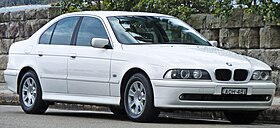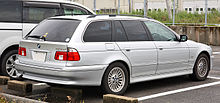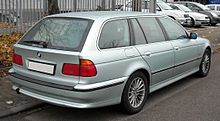This is an old revision of this page, as edited by MrsSnoozyTurtle (talk | contribs) at 21:28, 12 April 2016 (...Flexible Elec Design: WP:NOTHOWTO, WP:ESSAY. Running Changes: removing duplicated info, excessive detail (eg trim specifics for individual markets). Please consider WP:REVERT#Reverting multiple non-contiguous edits). The present address (URL) is a permanent link to this revision, which may differ significantly from the current revision.
Revision as of 21:28, 12 April 2016 by MrsSnoozyTurtle (talk | contribs) (...Flexible Elec Design: WP:NOTHOWTO, WP:ESSAY. Running Changes: removing duplicated info, excessive detail (eg trim specifics for individual markets). Please consider WP:REVERT#Reverting multiple non-contiguous edits)(diff) ← Previous revision | Latest revision (diff) | Newer revision → (diff) Motor vehicle| BMW 5 Series (E39) | |
|---|---|
 | |
| Overview | |
| Manufacturer | BMW |
| Production | September 1995 – June 2003 (sedan) June 1996 – April 2004 (wagon) |
| Assembly | Germany: Dingolfing Mexico: Toluca Russia: Kaliningrad |
| Designer | Joji Nagashima |
| Body and chassis | |
| Class | mid-size / E-segment |
| Body style | 4-door saloon 5-door estate |
| Layout | FR layout |
| Powertrain | |
| Engine | Petrol: 2.0-2.8 L I6 M52 2.2-3.0 L I6 M54 3.5-4.4 L V8 M62 4.9 L V8 S62 Diesel: 2.0 L turbo I4 M47 2.5 L turbo I6 M51 2.5-3.0 L turbo I6 M57 |
| Dimensions | |
| Wheelbase | 2,830 mm (111 in) |
| Length | sedan: 4,775 mm (188 in) wagon: 4,806 mm (189 in) |
| Width | 1,801 mm (71 in) |
| Height | sedan: 1,435 mm (56 in) wagon: 1,440 mm (57 in) |
| Chronology | |
| Predecessor | BMW E34 |
| Successor | BMW E60 |
The BMW E39 is the fourth generation of BMW 5 Series, which was sold from 1995 to 2004. It was launched in the sedan body style, with the "Touring" wagon (estate) body style introduced in 1996. The E39 was replaced by the E60 in 2003, however E39 Touring models remained in production until 2004.
The E39 was the first 5-Series to use aluminium components in the front suspension. Six-cylinder models use rack and pinion steering (for the first time in a 5-Series), while the V8 models use recirculating ball steering. Unlike its predecessor, the E39 was not available with all-wheel drive.
The M5 variant was introduced in 1998, powered by the 4.9-litre S62 V8 engine. It was produced in the sedan body style.
Development


Development for the E34's successor began in early 1989, internally known as "Entwicklung 39" and ended in 1995. The final design by Joji Nagashima was selected in 1992. The domestic German design patent was filed on April 20, 1994, utilizing an E39 prototype. The first pilot production models were built in February 1995, with full-scale production starting later in the year.
Chassis
Body
Compared with its E34 predecessor, the E39 wheelbase grew by 68 mm (2.7 in) and overall length by 55 mm (2.2 in). Torsional rigidity was increased over the E34 by 40 percent, which reduces body flex and allows the suspension to operate more accurately, also improving ride quality. Due to a stiffer body shell, the weight of the chassis increased by 10 kg (22 lb), which is offset by the aluminium suspension.
Structural dynamics was also an objective of the body design, so the body's frequencies for torsional twisting and bending are in separate ranges and above natural frequency. These frequencies are out of the range of engine and driveline vibrations, to avoid vibrations being amplified.
The aerodynamic design of the E39 resulting in a drag coefficient of 0.28.
The E39 draws heavily from the E38 7 Series in body construction and electronic technology.
Steering
Unusually, two vastly different steering systems were used for the E39, depending on the engine. Six-cylinder cars use rack and pinion steering, the first time this system has been used in a 5 Series. Cars with V8 engines use recirculating ball steering, as per the previous generations of 5 Series.
Suspension
The front suspension consists of MacPherson struts, with six-cylinder cars using an aluminium front subframe. Aluminium is used for the steering knuckles, outer strut tube and the spring pads, resulting in a weight saving of 21 kg (46 lb).
The rear suspension consists of a four link design (called "Z-link"), which is similar to the system used by the E38 7 Series. Chapman struts are used and the design minimises unintentional toe angle changes, which results in stable handling.
Engines
At launch, the petrol engines consisted of the M52 straight-six and M62 V8, which were both new engines at the time. In 1998, the "technical update" (TU) versions of these engines were introduced. At the 2000 facelift (LCI), the M52 straight-six engine was replaced by its successor the M54, however the M62 remained in use for the V8 models.
The initial diesel models used the M51 straight-six turbo-diesel engine. In 1998, its successor the M57 was introduced, however the M51 also remained in production for two more years. In 1999, the M47 four-cylinder turbo-diesel was introduced in the 520d model, which is the only E39 model to use a four-cylinder engine.
Petrol engines
| Model | Engine | Power | Torque | Body style | Years |
|---|---|---|---|---|---|
| 520i | M52B20 6-cyl |
110 kW (148 hp) @ 5900 | 190 N⋅m (140 ft⋅lbf) @ 4200 | sedan wagon |
1995–1998 |
| M52TUB20 6-cyl |
110 kW (148 hp) @ 6250 | 190 N⋅m (140 ft⋅lbf) @ 3500 | sedan, wagon |
1998–2000 | |
| M54B22 6-cyl |
125 kW (168 hp) @ 6250 | 210 N⋅m (150 ft⋅lbf) @ 3500 | sedan, wagon |
2000–2003 | |
| 523i | M52B25 6-cyl |
125 kW (168 hp) @ 5500 | 245 N⋅m (181 ft⋅lbf) @ 3950 | sedan, wagon |
1995–1998 |
| M52TUB25 6-cyl |
125 kW (168 hp) @ 5500 | 245 N⋅m (181 ft⋅lbf) @ 3500 | sedan, wagon |
1998–2000 | |
| 525i | M54B25 6-cyl |
141 kW (189 hp) @ 6000 | 245 N⋅m (181 ft⋅lbf) @ 3500 | sedan, wagon |
2000–2003 |
| 528i | M52B28 6-cyl |
142 kW (190 hp) @ 5300 | 280 N⋅m (210 ft⋅lbf) @ 3950 | sedan, wagon |
1995–1998 |
| M52TUB28 6-cyl |
142 kW (190 hp) @ 5500 | 280 N⋅m (210 ft⋅lbf) @ 3500 | sedan, wagon |
1998-2001 | |
| 530i | M54B30 6-cyl |
170 kW (228 hp) @ 5900 | 300 N⋅m (220 ft⋅lbf) @ 3500 | sedan, wagon |
2000–2003 |
| 535i | M62B35 V8 |
173 kW (232 hp) @ 5700 | 320 N⋅m (240 ft⋅lbf) @ 3300 | sedan | 1996–1998 |
| M62TUB35 V8 |
180 kW (241 hp) @ 5800 | 345 N⋅m (254 ft⋅lbf) @ 3800 | sedan | 1998–2003 | |
| 540i | M62B44 V8 |
210 kW (282 hp) @ 5400 | 440 N⋅m (320 ft⋅lbf) @ 3600 | sedan, wagon |
1995–1998 |
| M62TUB44 V8 |
217 kW (291 hp) @ 5400 | 460 N⋅m (340 ft⋅lbf) @ 3600 | sedan, wagon |
1998–2003 | |
| M5 | S62B50 V8 |
294 kW (394 hp) @ 6600 | 500 N⋅m (370 ft⋅lbf) @ 3800 | sedan | 1998–2003 |
Diesel engines
| Model | Engine | Power | Torque | Body style | Years |
|---|---|---|---|---|---|
| 520d | M47D20 4-cyl |
100 kW (134 hp) @ 4000 | 280 N⋅m (210 ft⋅lbf) @ 1750 | sedan, wagon |
2000–2003 |
| 525d | M57D25 6-cyl |
120 kW (161 hp) @ 4000 | 350 N⋅m (260 ft⋅lbf) @ 2000 | sedan, wagon |
2000–2003 |
| 525td | M51D25 UL 6-cyl |
85 kW (114 hp) @ 4800 | 230 N⋅m (170 ft⋅lbf) @ 1900 | sedan | 1996–2000 |
| 525tds | M51D25TU OL 6-cyl |
105 kW (141 hp) @ 4600 | 280 N⋅m (210 ft⋅lbf) @ 2200 | sedan, wagon |
1996–2000 |
| 530d | M57D30 6-cyl |
135 kW (181 hp) @ 4000 | 390 N⋅m (290 ft⋅lbf) @ 1750 | sedan, wagon |
1998–2000 |
| M57D30 6-cyl |
142 kW (190 hp) @ 4000 | 410 N⋅m (300 ft⋅lbf) @ 1750 | sedan, wagon |
2000–2003 |
- Figures specified are for European saloon models.
Drivetrain
Manual transmissions
- 5-speed ZF S5-39DZ (525d, 530d)
- 5-speed S5D 250G (523i from 1996, 520i, 525i)
- 5-speed S5D 260Z (525td)
- 5 speed S5D 320Z (523i up to 1996, 530i, 535i)
- 6-speed Getrag 420G (540i, M5)
Automatic transmissions
The 523i, 525i, 528i and 530i had several overlapping automatic transmission options.
- 4-speed GM 4L30-E (A4S270R) (523i and 528i- up to 1999)
- 5-speed GM 5L40-E (A5S360R) (523i and 528i- 1999-2000)
- 5-speed GM 5L40-E (A5S390R) (520i, 525i and 530i)
- 5-speed ZF 5HP19 (A5S325Z) (523i, 525i, 528, 530i)
- 5-speed ZF 5HP24 (A5S440Z) (540i after 1996, 535i)
- 5-speed ZF 5HP30 (A5S560Z) (540i model, 1996 only)
M5 version
Main article: BMW M5 § E39 M5 (1998–2003)The M5 version of the E39 was produced from 1998 to 2003. It was powered by the S62 V8 engine. All E39 M5 cars were sold in the sedan body style with a 6-speed manual transmission.
Yearly changes





Most changes occur in September each year, when the changes for the following model year go into production, as is typical BMW practice. Therefore the changes for 1996 represent the MY1997, for example.
1996
- Wagon/Estate body style (called Touring) introduced.
- 525td model introduced.
- USA sales commence, starting with the 528i and 540i models.
1997
- On-board computer upgraded.
- Rear side airbags introduced.
1998
- M5 model introduced Lower-body rear side airbags were standard on the M5, remaining optional for other models.
- M52 straight-six engines updated to M52TU.
- M62 V8 engines updated to M62TU.
- 530d model introduced, using the new M57 straight-six turbo-diesel engine.
- Xenon headlights introduced.
- Audible reversing alarm ("Park Distance Control") introduced.
- Self-levelling rear suspension introduced for estates.
- Stability control upgraded (from ASC+T to DSC).
1999
- Rain-sensing windshield wipers introduced.
2000 facelift
- 525i and 530i models (using M54 engines) replace the 523i and 528i model (M52TU engines).
- 525d model (using M57 engine) replaces the 525td model (M51 engine).
- 525tds model discontinued.
- 530d model receives power increase.
- 520d introduced, powered by a four-cylinder diesel engine.
- Revised "angel eye" headlights.
- Revised tail lights with LED brake lights.
- Navigation screen updated from 4:3 to larger 16:9 widescreen.
2001
- Automatic transmission cars had the manual shift direction switched (to forwards for downshifts, backwards for upshifts).
- Automatic headlights introduced.
2002
- Consumer Reports declared the 2002 BMW E39 the best car they had ever reviewed.
- Navigation upgraded from CD-ROM format (8 CDs to cover USA and Canada) to a single DVD-ROM.
2003
- 540i M-sport limited edition model produced.
North American model range
The North American model range at the 1996 launch consisted of the 528i and 540i. Standard equipment on both models included dual front and side airbags, anti-lock brakes, traction control, power steering, and air conditioning.
In 1998, the M5 was added to the USA model range. Following the 2000 facelift, the USA model range consisted of the 525i and 530i, 540i and M5. Therefore, the 520i, 535i and diesel models were not sold in the USA.
References
- "Vehicle manufacturer profiles". www.automotiveworld.com. Retrieved 2010-11-16.
- "Группа компаний Автотор :: Автомобили BMW". www.avtotor.ru (in Russian). Retrieved 2010-10-03.
- "1997 BMW 528i specifications". www.automobile-catalog.com.
- ^ "BMW E39: Joji Nagashima - die Übergangslösung". www.auto-motor-und-sport.de.
- "Bavarian Dreams: The 10 Best Designed BMWs of All Time". www.au.complex.com.
- ^ "Professional Development Department E39 Introduction". BMW of North America, Inc. 1996.
{{cite journal}}: Cite journal requires|journal=(help) - "BMW E39 5-Series (1996-03)". www.carpoint.com.au. Archived from the original on November 10, 2007.
{{cite web}}: Unknown parameter|deadurl=ignored (|url-status=suggested) (help) - "Bent-Eight Beemer". www.autospeed.com.au. Archived from the original on 21 September 2007.
{{cite web}}: Unknown parameter|deadurl=ignored (|url-status=suggested) (help) - "Autoweek Carbase for BMW 5-series". www.autoweek.nl (in Dutch). Archived from the original on 9 August 2007.
{{cite web}}: Unknown parameter|deadurl=ignored (|url-status=suggested) (help) - ^ Larimer, Fred (2002). BMW Buyer's Guide. MotorBooks International. p. 154. ISBN 0-7603-1099-8.
- ^ "Electronic Transmission Control" (PDF). www.e38.org. Retrieved 2015-03-25.
- "BMW Transmission and Oil Application Chart - BMW Doc SD 92-113". www.bimmerfest.com.
- "2001 BMW M5 Review". www.jbcarpages.com. Retrieved 2011-04-03.
- "MKIV". www.bimmernav.com. Retrieved 2010-10-03.
| « previous — BMW cars: 1980s to 2000s — next » | |||||||||||||||||||||||||||||||||||||||||||||||||||||||||||||||||||||||||||||||||||||||||||||||||||||||||||||||||||||||||||||||||||||||||||||||||||||||||||||||||||||||||||||||||||||||||||||||||||||||||||||||||||||||||||||||||||||||||||||||||||||||||||||||||||||||||||||||||||||||||||||||||||||||||||||||||||||
|---|---|---|---|---|---|---|---|---|---|---|---|---|---|---|---|---|---|---|---|---|---|---|---|---|---|---|---|---|---|---|---|---|---|---|---|---|---|---|---|---|---|---|---|---|---|---|---|---|---|---|---|---|---|---|---|---|---|---|---|---|---|---|---|---|---|---|---|---|---|---|---|---|---|---|---|---|---|---|---|---|---|---|---|---|---|---|---|---|---|---|---|---|---|---|---|---|---|---|---|---|---|---|---|---|---|---|---|---|---|---|---|---|---|---|---|---|---|---|---|---|---|---|---|---|---|---|---|---|---|---|---|---|---|---|---|---|---|---|---|---|---|---|---|---|---|---|---|---|---|---|---|---|---|---|---|---|---|---|---|---|---|---|---|---|---|---|---|---|---|---|---|---|---|---|---|---|---|---|---|---|---|---|---|---|---|---|---|---|---|---|---|---|---|---|---|---|---|---|---|---|---|---|---|---|---|---|---|---|---|---|---|---|---|---|---|---|---|---|---|---|---|---|---|---|---|---|---|---|---|---|---|---|---|---|---|---|---|---|---|---|---|---|---|---|---|---|---|---|---|---|---|---|---|---|---|---|---|---|---|---|---|---|---|---|---|---|---|---|---|---|---|---|---|---|---|---|---|---|---|---|---|---|---|---|---|---|---|---|---|---|---|---|---|---|---|---|---|---|---|---|---|---|---|---|---|---|---|---|---|
| |||||||||||||||||||||||||||||||||||||||||||||||||||||||||||||||||||||||||||||||||||||||||||||||||||||||||||||||||||||||||||||||||||||||||||||||||||||||||||||||||||||||||||||||||||||||||||||||||||||||||||||||||||||||||||||||||||||||||||||||||||||||||||||||||||||||||||||||||||||||||||||||||||||||||||||||||||||